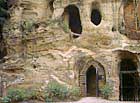

Ye Olde Trip to Jerusalem team
[Nottingham history]
![]()
the caves of Nottingham
 |
Mortimer's Hole |
Between the twin hills now occupied by the Castle and St Mary's Church grew the town of Nottingham. It is riddled with caves -- over 400 in the city centre alone -- all of which were scraped and hacked out of the soft sandstone rock on which the town was founded. These caves provided shelter, wells and places for industry, brewing and storage.
The first written reference to the caves occurs in a biography of Alfred the Great, written before AD 913, in which the Celtic name of the settlement is given as Tigguo Cobauc -- 'place of cavy dwellings'. The sandstone cliffs were ideal for burrowing into horizontally to create such dwellings, but the most common technique was to build a house against a cliff and dig out caves in the back for extra living room or to act as workshops or stores. Some were even used as chapels, and at the Old Town Hall at Weekday Cross and at the County Gaol in High Pavement, they provided another form of residence -- dungeons. During World War II, they were used as air raid shelters -- on 8 May 1941, more than 500 high-explosive bombs were dropped on the town, killing over 200 people.
Drury Hill, a steep, narrow road, was the main route into town via Bridlesmith Gate to the Market Place. It was built above the most extensive set of caves in the centre of town, and many shops, pubs and dwellings along its length had basements, store chambers and workrooms hacked out of the rock below.
Eighteen malt kiln caves have been found in Nottingham. One in the upper part of Drury Hill yielded 13th-century pottery, and a particularly fine example is now under an office building in Castle Gate. The malt kilns were circular, with a lower section for a charcoal fire and ledges above for roasting grain. Water came from a well dug through the rock, and there would be a larger cavern -- often with a central pillar for support -- for germinating grain.
The constant temperature of the caves -- about 13.9 degrees C (57 degrees F) -- is ideal for the storage of beer and wine, and the excavation of storage cellars under public houses became a widespread practice. The Bell Inn, the Salutation and the Trip to Jerusalem all have such cellars.
In medieval Nottingham, leather was a staple material for clothing (boots, shoes, gloves and belts), animal harness, sacks, bottles, drinking vessels and for military use (scabbards, quivers, helmets, armour and shields). Two caves at Broad Marsh, dating from 1250, once comprised the only underground tannery in Britain. The area was ideal for tanning: skins were available from Nottingham's butchers, the oak bark used in the process came from Sherwood Forest and water from the nearby River Leen. During the curing process, the skins would be immersed in barrels sunk into the ground -- the remains of the barrel pits can be seen in the Pillar Cave -- and in clay-lined vats. The work was hard, dirty and very smelly.
Drinking water has been drawn up from wells cut through the sandstone for many centuries. Unfortunately pits for the disposal of human excrement were often dug alongside, contaminating the water. In 1832, cholera struck -- 'this terrible scourge', according to the borough records of the time -- but the town was saved from a second epidemic by the installation of piped water by Thomas Hawksley later in the same year.
When the Broad Marsh Centre was constructed in 1968/9, the caves under Drury Hill would have been lost if it hadn't been for the efforts of the Nottingham Historical and Archaeological Society, whose members cleared and plotted them. Together with the newly formed Nottingham Civic Society, they mobilised public opinion to prevent the caves from being filled with concrete, and plans for the shopping centre were modified. From 1977, the Friends of Nottingham Museums gave guided cave tours, and in 1994, the city council backed a proposal to construct an entrance to the caves. Over £200,000 was spent to create the Caves of Nottingham exhibition.